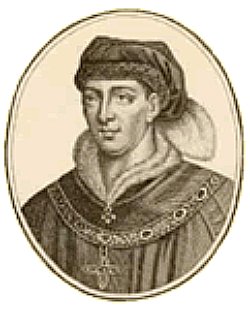
Humphrey Stafford, 1st Duke of Buckingham
Born: August 15, 1402
Stafford, Staffordshire, England
Died: July 10, 1460
Northampton, Northamptonshire, England (Age 57)
Buckingham in History
Humphrey Stafford was the eldest son and heir of Edmund Stafford and Anne of Woodstock, daughter of Thomas of Woodstock, the fifth and youngest surviving son of Edward III. Although Humphrey's royal blood would ultimately gain him a good amount of wealth and fame in England, his early life was not an easy one. His father's life was cut short the year after Humphrey's birth when he died fighting for Henry IV at the Battle of Shrewsbury. At this point, his mother took control of his finances, and even when Humphrey came of age, he did not fully inherit his father's lands and lived quite uncomfortably from a financial standpoint. Throughout this period, Humphrey remained a loyal Lancastrian supporter and was knighted by Henry V in 1421. The following year, after the death of Henry V and the accession of his nine-month-old son Henry VI, Humprhey would take a more active role in government. He became an important member of the minority council and held a number of crucial positions in France (which Henry V had conquered a large portion of), including governor of Paris. In 1438, Humphrey's mother died, and he inherited all of his father's (and mother's) vast titles and estates, which included the Earldom of Buckingham (which his grandfather, Thomas of Woodstock, had once held). This indeed ended his financial difficulties for the time being.
The court of Henry VI was always a wasp's nest of political strife (mainly over the situation in France in the first half of his reign), and Buckingham began to side more with the king's great-uncle Henry Beaufort, Cardinal of Winchester over the king's uncle Humphrey, Duke of Gloucester, on the topic of peace with France (the Cardinal wanted peace while Gloucester urged for the war to continue). In 1444, Stafford was upgraded to Duke of Buckingham and served more actively with the king. He was present at the arrest of Gloucester in 1447 (he died soon after) and took part in the trials after Jack Cade's rebellion in 1450. After the exile and murder of the Duke of Suffolk that same year, Buckingham became a supporter of the king's new favorite, the Duke of Somerset. Unfortunately, Somerset was becoming increasingly unpopular due to the fact that, by 1453, he was responsible for the complete loss of the English territories in France.
By this point, two rival factions had formed: the Lancastrians (those who supported the king) and the Yorkists (those whose supported the Duke of York, a man who had a valid claim to the throne through his mother's side). York and Somerset were bitter enemies, and when Somerset would not be removed from his place of power (thanks to Queen Margaret) the two factions did battle at St Albans in 1455. Buckingham fought for the Lancastrians and was wounded during the battle, which saw the death of Somerset and the defeat of the Lancastrians. After St Albans, Buckingham pushed for peace with the Yorkists but ultimately continued to support the king (Queen Margaret certainly put pressure on him). By 1460, the conflict between the Lancastrians and Yorkists was at its boiling point, and huge changes were about to occur. The two factions did battle at Northampton that year, and Buckingham was killed in the action by some Kentishmen who had participated in Cade's rebellion ten years earlier. Duke Humphrey was fifty-seven at the time of his death. Although Buckingham remained loyal to his king, it does not seem as if he was sorely missed. It seems that he was merely one of the many magnates that gave their lives in the Wars of the Roses (what the conflict between the houses of Lancaster and York has come to be known as). The Dukedom of Buckingham was inherited by his grandson Henry, who would be crucial to putting Richard III on England's throne, only to die in rebellion against him, another victim of the Wars of the Roses.
Buckingham in Shakespeare
Appears in: Henry VI, Part 2
Buckingham appears as a fairly significant character in 2 Henry VI. He is a loyal Lancastrian supporter and fights for the Lancastrians at St Albans, where he is wounded. At the beginning of 3 Henry VI, the Yorkists report that Buckingham has been either wounded or killed during the battle. He is not mentioned again. In reality, Buckingham died in 1460, five years after the Battle of St Albans, at the Battle of Northampton.While Buckingham is not seen again, his grandson and heir is a major character in Richard III, who is ultimately executed by the tyrant king for turning on him.
References
Rawcliffe, Carole. ‘Stafford, Humphrey, first duke of Buckingham (1402–1460)’, Oxford Dictionary of National Biography, Oxford University Press, Sept 2004; online edn, Jan 2008 [http://www.oxforddnb.com/view/article/26207, accessed 28 Dec 2009]